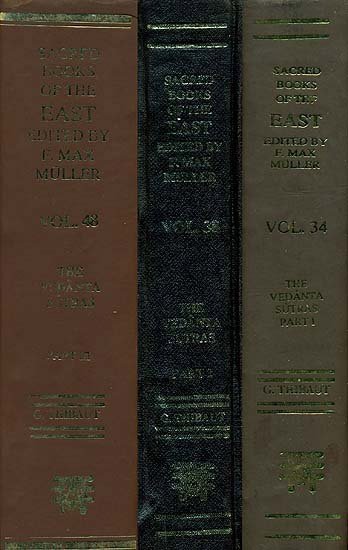Brahma Sutras (Ramanuja)
by George Thibaut | 1904 | 275,953 words | ISBN-10: 8120801350 | ISBN-13: 9788120801356
The English translation of the Brahma Sutras (also, Vedanta Sutras) with commentary by Ramanuja (known as the Sri Bhasya). The Brahmasutra expounds the essential philosophy of the Upanishads which, primarily revolving around the knowledge of Brahman and Atman, represents the foundation of Vedanta. Ramanjua’s interpretation of these sutras from a V...
Sutra 1.1.25
25. The light (is Brahman), on account of the mention of feet.
We read in the Chāndogya. (III, 13, 7), 'Now that light which shines above this heaven, higher than everything, in the highest worlds beyond which there are no other worlds, that is the same light which is within man.'—Here a doubt arises, viz. whether the brightly shining thing here called 'light' is the well-known light of the sun and so on, viewed as a causal universal principle (Brahman); or the all-knowing, etc., highest Person of infinite splendour, who is different in nature from all sentient and non-sentient beings, and is the highest cause.—The Pūrvapakshin maintains that the reference is to ordinary light. For, he says, the passage does not mention a particular characteristic attribute which can belong to the highest Self only—while such attributes were met with in the texts referring to Ether and Breath—, and as thus there is no opening for a recognition of the highest Self, and as at the same time the text identifies 'light' with the intestinal heat of living beings, we conclude that the text represents the well-known ordinary light as Brahman, the cause of the world—which is possible as causal agency is connected with extreme light and heat.—This primā facie view the Sūtra sets aside. The light which the text states to be connected with heaven and possessing supreme splendour can be the highest Person only, since a preceding passage in the same section—' All the beings are one foot of it, three feet are the Immortal in heaven'—refers to all beings as being a foot of that same being which is connected with heaven. Although the passage, 'That light which shines above,' etc., does not mention a special attribute of the highest Person, yet the passage previously quoted refers to the highest Person as connected with heaven, and we therefore recognise that Person as the light connected with heaven, mentioned in the subsequent passage.
Nor does the identification, made in a clause of the text, of light with the intestinal heat give rise to any difficulty; for that clause is meant to enjoin meditation on the highest Brahman in the form of intestinal heat, such meditation having a special result of its own. Moreover, the Lord himself declares that he constitutes the Self of the intestinal fire, 'Becoming the Vaiśvānara-fire I abide in the body of living creatures' (Bha. Gī. XV, 14).
